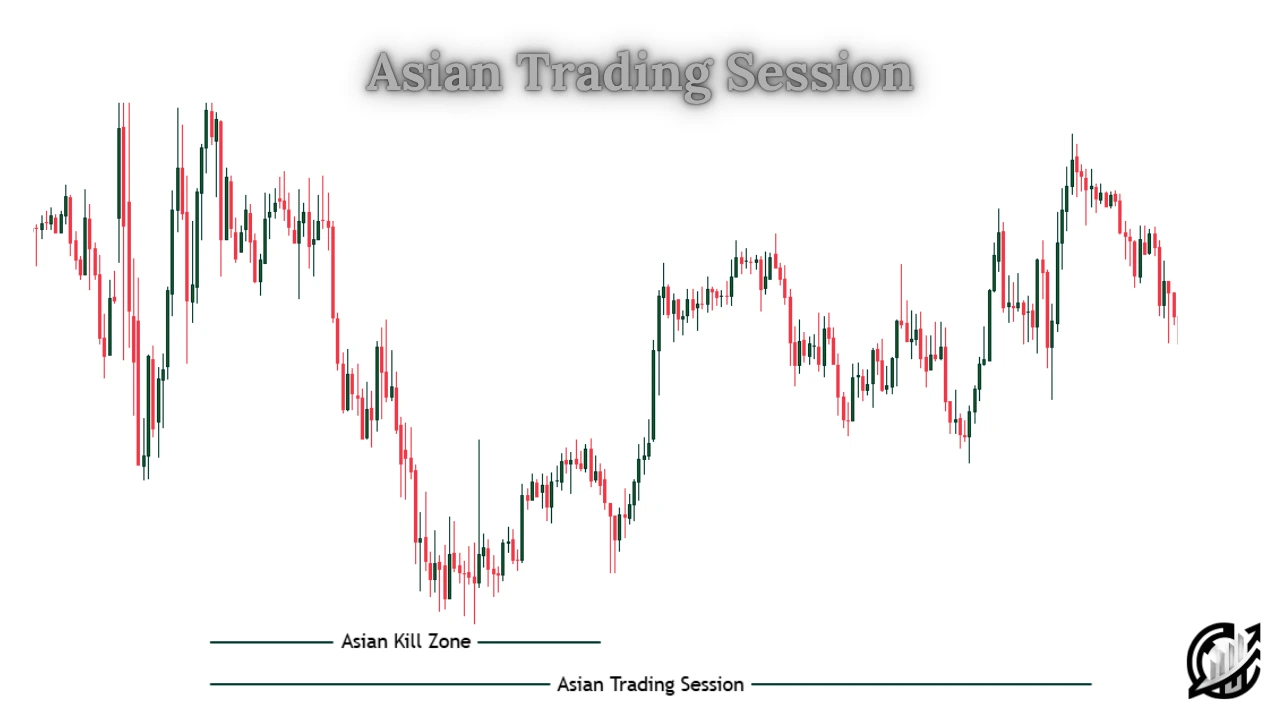Last Updated on August 12, 2025

Table of Contents
Foreign Exchange Market operates twenty-four hours a day, and five days a week. Forex market is global and decentralized, and operates with different financial centers opening and closing. Among these, the Asian trading session is equally important for traders who want to take advantage of early market sentiment.
Asian session is characterized of low volume and volatility. However, traders often find high-probability trades in less volatile market.
This article explores understanding and essentials of Asian Session, and strategies and pairs used by smart money traders in trading Asian session.
Overview of the Asian Trading Session
Asian Trading Session is also known as Tokyo trading session. It is the first major forex trading session of the day. It kicks off after the weekend break and sets the tone for the upcoming sessions.
The session typically starts at 7:00 PM and ends at 4:00 AM New York. However, the liquidity generally builds to begin Sydney Trading Session open, and intensifies when Tokyo begins operations an hour later. Asian Session (Tokyo session) has low volatility and price movement when compared with London trading session and New York Session.

As far as price action is concerned, most of the pairs has low volume and range in a tight consolidation. In this session, currency pairs with JPY, AUD, and NZD exhibit higher activity in this session.
Key financial centers operate in Tokyo (Japan), Sydney (Australia), and Hong Kong and Singapore. Tokyo is the most influential player in this session. Sydney opens earlier and influences initial price movement. As far as Hong Kong and Singapore is concerned, its major financial hub contributing to liquidity and volume.
Importance of Asian Trading Session
As we know that Asian session is not as volatile as London trading session and New York trading sessions. However, it plays a critical role in the market structure.
Being the first trading session of week, the Asian session reacts to weekend news (mostly geopolitical or economic events), opening of the global equity and bond markets, and economic releases from countries like Japan, Australia, and China.
Price action is also notable in this session. Though the price movements tend to be more range-bound, Tokyo session often sets the initial trend or price bias for the day. Traders can often see consolidations or setups for breakouts that occur in the London Session.
Kill Zone in Asian Trading Session
This concept is highly influential in trading. Although market is less volatile, but, in kill zone, market reacts violently and show the appearance of volume. This concept is popular among ICT traders. Asian kill zone is timed between 7:00 PM to 11 PM New York time.
Asian kill zone identifies window of opportunities within the session. Market tends to establish a tight range during this kill zone. Price often sweeps stops just above and below the Asian range.
This liquidity sweep is designed to trap traders who enter prematurely. These traps set the stage for more significant moves during the London Open Kill zone.
Apart from this general perception of market structure during Asian kill zone, traders must analyze market structure on higher timeframes. As an SMC trader, we must look for the session highs and lows, swing highs and lows, break of structure, and change of character. This confirms direction of the move.
Influential Currency Pairs
The most active and liquid currency pairs during this session involve Asia-Pacific currencies. These currencies include:
- USD/JPY
- AUD/USD
- NZD/USD
- AUD/JPY
- EUR/JPY
- GBP/JPY
The Japanese Yen is one of the most traded currencies due to Japan’s strong economy. There are other factors like export-focused industry and active retail investor base. During the trading session, JPY pair see tighter spreads and better execution due to higher liquidity.
Characteristics of Asian Trading Session
Along with weaknesses, there are factors that can contribute better opportunities. There are characteristics of Asian session that a trader must consider before trading Asian session.
One of the characteristics is its lower volatility. In Asian Session, price movement generally exhibit slower price action and tight ranges compared to London or New York session. This factor makes it ideal for range traders, those who prefer less volatile markets.
Most of the time, market consolidates during the Asian Session hours before breaking out during the London open. This gives opportunities for traders to anticipate moves based on Asian session highs and lows.
Since the volume is relatively low, price action during the Asian session tends to respect supply and demand zones better. As an SMC trader, you can use candle range concept for precision trading in narrow range markets.
Best Trading Strategies for the Asian Session
Trading strategies depends on traders’ selection. Whether you follow indicator-based trading or price action, it should be aligned with your trading psychology. The following are the strategies mostly preferred in Asian session: Range-based trading, breakout trading, and news-based trading.
When price moves between tight supply and demand zones, range trading is highly effective. The rule is that you must identify strong horizontal supply and demand zone and aim for 10-30 pip gains per trade. Remember, set tight stop-loss just outside the range boundaries.
As the London Session nears, liquidity and volume increases, leading to breakouts from the Asian range. As an SMC trader, you should draw the high and low of the Asian session range. Lastly, confirm it with volume or momentum indicators and enter in the direction of the breakout with SL below/above the breakout candle.
High-impact economic events from Japan, Australia, or China can create sharp moves. Your have to check economic on daily basis, and trade only if the expected volatility suits your risk appetite.
Pros and Cons of Trading Asian Session
The following are pros of Asian Session:
- It has lower volatility which reduces the risk of large whipsaws.
- It is suitable for part-time or night-time traders in Asia-Pacific.
- It is easier to trade with small accounts due to tighter ranges.
- It prepares the ground for setups in London session.
The following are the cons of Asian Session:
- It has low volatility and can often lead to false breakouts.
- It may require more patience because price moves slowly.
- There are limited trading opportunities.
Key Tips for Asian Session Traders
The following are the tips for Asian Session traders:
- Avoid trading during market open gaps, especially the first 15-30 minutes of the Sydney or Tokyo open
- Focus on pairs like JPY, AUD, and NZD pairs where liquidity is higher.
- Watch for Asian Session high and low levels. These levels often serve as liquidity zones in later sessions.
- Try to find trade but do not force the market. If market is flat, wait for better trade setups.
- If possible, use tools like ADR (Average Daily Range) to manage expectations for pip movements.
Final Note
Asian trading session might be quieter than its counterparts. However, it provides valuable trading opportunities only if you are disciplined trader. Try to align your trading psychology and strategy for better results.
Financial market’s trading carries risk. Try to consult financial advisor before trading the markets. Always risk the capital that can afford to lose. This writing is for educational purpose only. Conduct your own research before investing and trading.
FAQs
What are the timings of Asian Trading Session?
The Asian trading session typically starts at 7:00 PM and ends at 4:00 AM New York. Liquidity building starts at Sydney open.
Which currency pairs are most active in the Asian session?
USD/JPY, AUD/USD, NZD/USD, and cross pairs like AUD/JPY, and EUR/JPY are the most liquid pairs.
Is the Asian session good for beginners?
Technically, it is the most favorable for beginner forex traders. Its lower volatility and technical price movement make it ideal for beginners.
What is the best strategy for the Asian session?
Range trading and London breakout setups work best due to calm structured price movements.
Do fundamentals matter in the Asian session?
Yes, it works accurately in the market session. Economic news from Japan, Australia, or China can significantly move the currency pairs.
I’m Abdullah Shah, a content writer with three years of experience in crafting engaging and informative content. My background in market analysis complements my work, allowing me to create content that resonates with audiences. I’m also a seasoned practitioner in the forex and crypto markets, with a strong foundation and deep interest in finance. My passion for the financial world drives me to produce content that is both insightful and valuable for those interested in understanding market trends and financial strategies.





